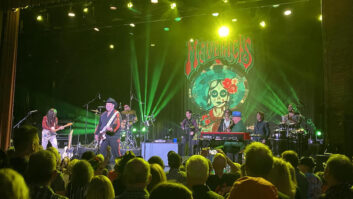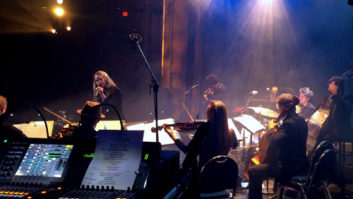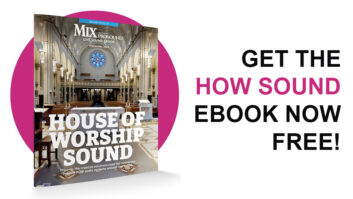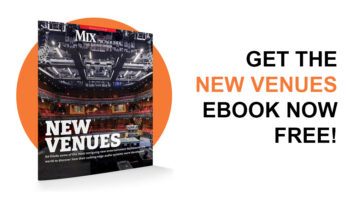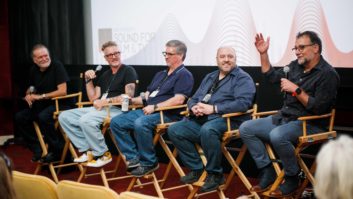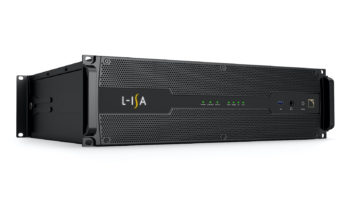Fountains of Wayne, performing at the Tarrytown Music Hall
Tarrytown, NY (August 14, 2013)—When it comes to colorful local history, Tarrytown has plenty to spare. Located an hour north of New York City, the small Hudson River town at one end of the Tappan Zee Bridge was the site of a major Revolutionary War incident, when Major John Andre was arrested as a spy; was the village Ichabod Crane rode through in the fictional Legend of Sleepy Hollow; and has been called home by the likes of John D. Rockefeller, Bruce Jenner, Mark Twain and Cab Calloway.

It also happens to be where I grew up, and for a media-obsessed kid, one of the most interesting remnants of Tarrytown’s history was the Music Hall, an 860-seat venue built in 1885 that a century later was a rarely used rental house. Built by chocolate manufacturer William Wallace, the imposing building with its beautiful Queen Anne brick facade had hosted the likes of Mae West and Woodrow Wilson in decades past, but had been converted into a movie theater that closed in the mid-Seventies, when it was nearly turned into a parking lot.
Placed on the National Register for Historic Places in 1980 and envisioned as a potential cultural destination, the Music Hall initially struggled to come back (and indeed continues to be restored to this day, thanks to donations), but now hosts a robust, eclectic line-up of artists year-round. Just one recent month saw the Music Hall present no less than 16 shows, with acts like singer/songwriter Aimee Mann, indie rockers Fountains of Wayne, kiddie songstress Laurie Berkner, maverick film director John Waters, R&B legend Smokey Robinson, The Daily Show’s John Oliver, jazz master Gato Barbieri and others. To say it offers something for everyone is an understatement.
Providing sound for all those events is Boulevard Pro (Ridgefield Park, NJ), the Music Hall’s first-call audio vendor, which brings in a variety of control gear and backline for each show, running sound through the house PA. “The biggest consideration was that everything had to be self-powered because there’s no room,” said Björn Olsson, executive director of the Music Hall. “We installed a Meyer Sound rig, and we bring in a L-Acoustics self-powered monitor system most times because there’s no place for amp racks in the wings. It’s a very good system; they’re pretty durable because they’ve had every kind of show possible go through them, 200 shows a year, and I’ve never seen them fail.”
The Meyer system in question is an M2D compact curvilinear array, backed up by HP-700 subs and M1Ds, purchased through Sound Associates in Yonkers, NY. Because the aging venue can’t support a flown system, the M2Ds are groundstacked, with five placed upon a single sub on each side of the stage. The bottom three boxes per side fill the orchestra, the top boxes fill the balcony seating, and it’s all been tuned with Meyer Galileo software.
While the wood-and-plaster venue was built in a time before electric amplification, Anthony Cioffi, Boulevard Pro’s owner and director of production, suspects that’s part of why it’s such a good-sounding room: “Back then, it was vaudeville and community gatherings, and all that was done without amplification. Now you have those natural acoustics and they work to your benefit if you’re an engineer who knows not overpower the room. We have the challenge of a small stage, so the monitors can sometimes overwhelm the front of house, but in general, most people love our sound.”
Sharing its walls with a number of stores, restaurants and apartments, the venue has a 100 dB limit at FOH, which is appropriate for the room, as well as most of the acts that play there. “We know that if we book Todd Rundgren again, it’s going to be a loud night,” Olsson laughed, “but it should be in a way, because that’s what he does and we’ve come to accept that. Still, we try to keep it within 100 decibels, not only for the neighbors but for the integrity of the building; everything starts shaking loose!”
Because of the variety of shows and events at the Music Hall, ranging from rock concerts to dance school recitals, the venue has its own mixers—a Midas Venice 320 and a Yamaha M7CL—but it still brings in whatever a rider requires, such as the Fountains of Wayne show, which found Boulevard Pro fielding a Yamaha PM5D at the FOH position and a CL5 for monitors.
Bringing in gear is no picnic, however, since the load-in door isn’t at stage level; instead, it’s at the back house left of the orchestra, three steps above street level (there’s no nearby parking lot). Thus once gear is rolled or lifted in, it has to be rolled between irreplaceable antique glass partitions, then down a 4-foot-wide orchestra aisle to another ramp to get it on stage. Once gear is up there, it needs to be taken out of cases and off wheels ASAP—otherwise it’s liable to roll right off the traditionally raked stage.
Despite the Music Hall’s oddities, it’s become a standard tour stop for many acts, and that popularity has only grown over time. In the 10 years since Olsson came aboard, its budget has grown from $130,000 to roughly $3 million today and the number of annual visitors has risen from 15,000 to 85,000. That influx of visitors has in turn helped revitalize the town’s Main Street, as the venue generates more than $1 million annually for the community, in recent times helping attract art galleries, restaurants and even a high-end guitar boutique to the area.
The good vibes that have extended out to the community, however, are mirrored inside the Hall, too. “We work in a lot of venues,” said Boulevard Pro’s Cioffi, “and this place? It’s quirky and nothing is exactly perfect, but I like it. This is our favorite theater!”
Tarrytown Music Hall
www.tarrytownmusichall.org
Boulevard Pro
www.blvdpro.com
